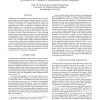Free Online Productivity Tools
i2Speak
i2Symbol
i2OCR
iTex2Img
iWeb2Print
iWeb2Shot
i2Type
iPdf2Split
iPdf2Merge
i2Bopomofo
i2Arabic
i2Style
i2Image
i2PDF
iLatex2Rtf
Sci2ools
ICIP
2004
IEEE
2004
IEEE
Steganalysis of quantization index modulation data hiding
Quantization index modulation (QIM) techniques have been gaining popularity in the data hiding community because of their robustness and information-theoretic optimality against a large class of attacks. In this paper, we consider detecting the presence of QIM hidden data, which is an important consideration when data hiding is used for covert communication, or steganography. For a given host distribution, we are able to quantify detectability compactly in terms of a parameter related to the robustness of the hiding scheme to attacks. Using detection theory we show that QIM quickly transitions from easily detectable to virtually undetectable as this parameter varies. We also obtain performance benchmarks for QIM hiding in images, indicating that a scheme designed to be robust to, say, a moderate degree of JPEG compression, should be easily detectable. While practical application of detection theory to images is difficult because of statistical variations across images, we employ super...
Data Hiding Community | Detection Theory | ICIP 2004 | Image Processing | Information-theoretic Optimality | QIM Hidden Data | Quantization Index Modulation |
Related Content
| Added | 24 Oct 2009 |
| Updated | 24 Oct 2009 |
| Type | Conference |
| Year | 2004 |
| Where | ICIP |
| Authors | Kenneth Sullivan, Zhiqiang Bi, Upamanyu Madhow, Shivkumar Chandrasekaran, B. S. Manjunath |
Comments (0)

